May 17 - 23, 2020: Issue 450
The Pittwater Floating Hotels That Almost Were: Old Paddle Steamers, Fairmiles + A Current 'Lilypad'
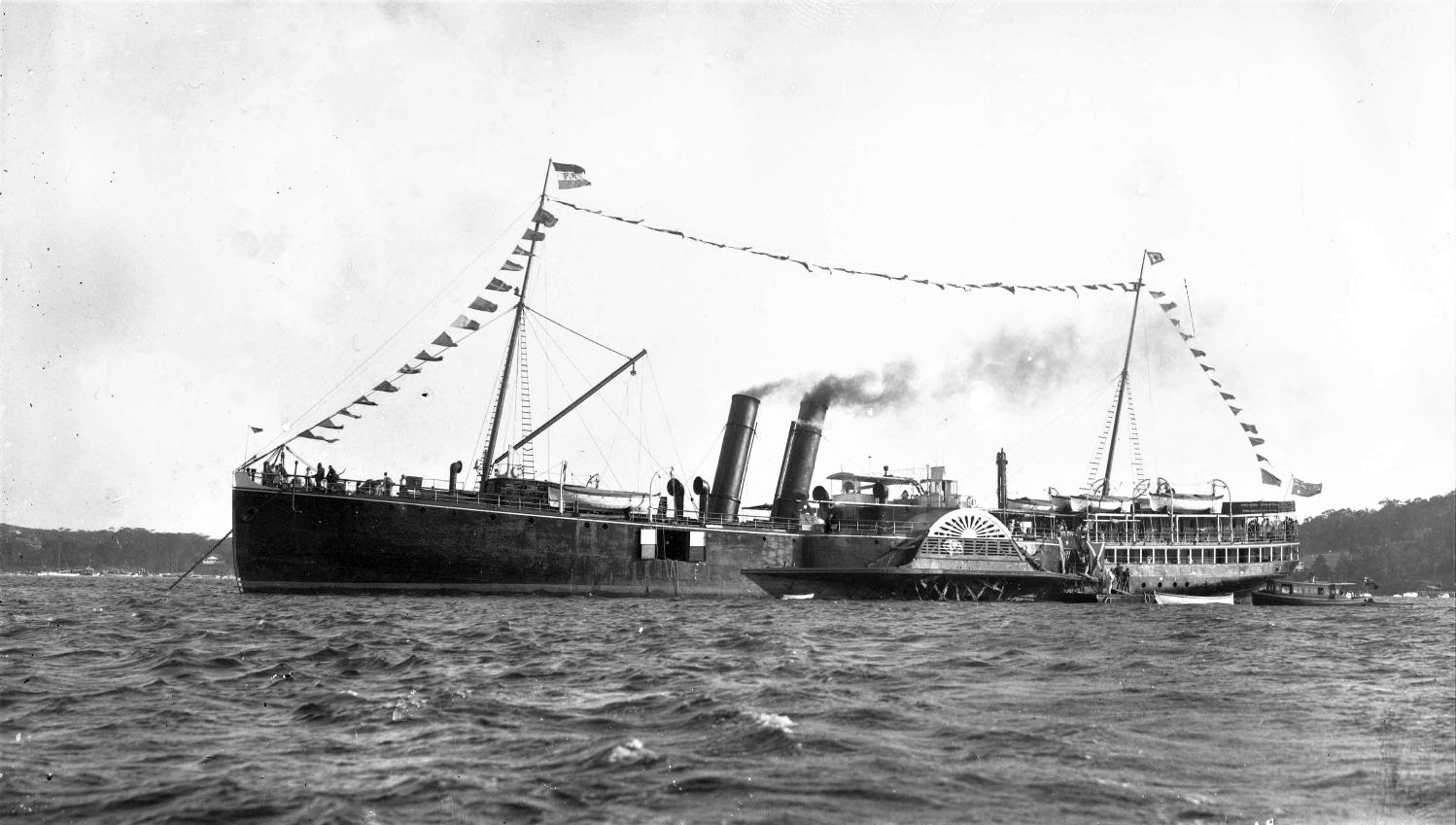
When researching the glorious old steamers and ferries that would act as flagships for Pittwater Regattas some Readers marvelled at the size of some of the vessels used - the SS Archer (1925 regatta) SS Newcastle (1922, 1923, 1924 and 1927) and the SS Gwydir (1933-35) were all sizeable ships and needed to moor in the deeper parts of the estuary, off Bayview or Scotland Island.
They also provided on board accommodation for those coming to Pittwater for the regattas, usually held just after Christmas and a round New Years, and would be surrounded by a flotilla of other yachts and cruisers, also acting as a place to sleep for those lucky souls fortunate enough to be able to afford something a bit longer and wider with berths and deck areas for visitors to camp down and enjoy the best place in Sydney.
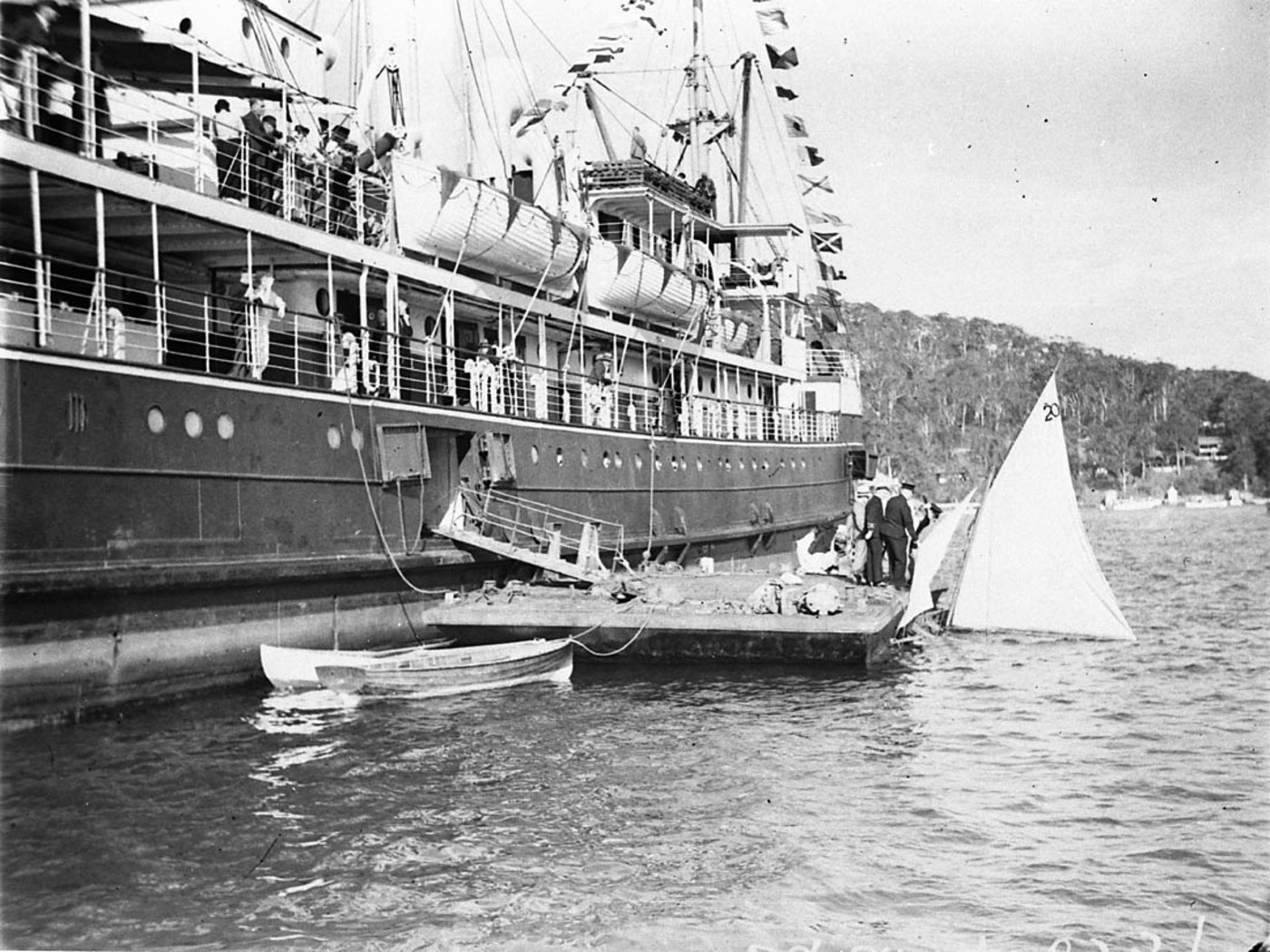
Flagship "Gwydir" at Pittwater Regatta, showing boarding pontoon moored beside, Item: hood_06537h, courtesy the State Library of New South Wales.
Accommodation aboard steamers was not unusual, most were built to run up and down the coats of Australia and over to New Zealand, so cabins for those travelling on the longer legs, overnight, were built as part of the fit-outs for these vessels. Even past their commercial use some were repurposed as holiday accommodation locally, those refitted by Mr. Edward Windybanks were offered at the Cowan Creek, while the Kuring-gai Chase National Park trustees also had a 'houseboat' used for meetings of the Trust and entertaining guests.
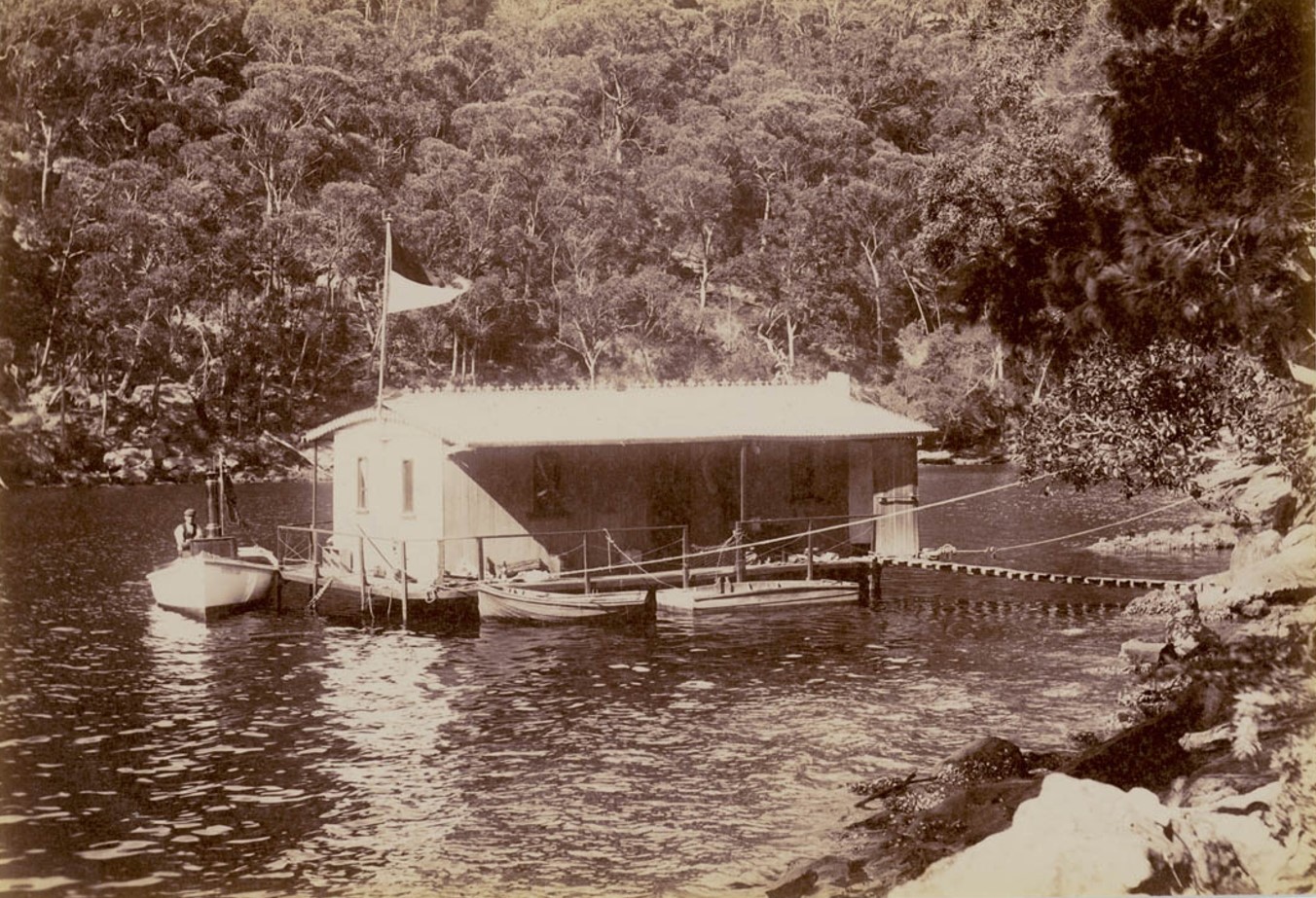
'Kuring Gai ' House boat, Cowan Creek, Kuring Gai Chase [including steam launch "Kuring Gai"]. Item: a116504h, courtesy the State Library of New South Wales.
FISHING NOTES (By 'GLAUCUS.')
I HAVE just had an interesting stay at Cowan Creek on one of the houseboats in that popular resort, Mr. S. Baldock having kindly placed his neat little boat at my disposal. Ned Windybank also assisted to make the trip a pleasant one with his kindly hospitality, so while the city folk were wondering what kind of winter was coming on top of the coastal gales, I was putting In a quiet, healthful stay in the sheltered creek. It is strange that so few people know anything about life on a houseboat. It is such a free and easy life that it should specially appeal to Australians. It is far preferable to camping in a tent, and one can safely take children on to the roomy boats. Mr. Baldock's house on the water is at Coal and Candle Bay, near one of the best grounds for schnapper in the whole of the deep water of Cowan. It has been well planned and constructed, and is very suitable for a small party of half a dozen men. It represents a good many hours of labor by a busy man In his spare time, and when completely finished will be as comfortable a temporary home as one could wish for. It is small, but then it has not been built for a large crowd, and the men who use it are all fond of fishing, and really only require the place for the night. Ned Windybank's fine Fairyland is near, and there is a plentiful supply of water in the creek a hundred yards away. I only succeeded in raising one of the Cowan schnapper, a five pounder, that provided a tasty meal for the family, but there were plenty of small fish in the place. A large skate was the first fish to be grilled. The flaps of a twelve pounder made two excellent meals. The leather-Jackets are very plentiful and are of all colors. They are as razor toothed as ever. The skate tasted like tender lobster, and was a decided success. FISHING NOTES. (1903, June 3). Referee (Sydney, NSW : 1886 - 1939), p. 6. Retrieved from http://nla.gov.au/nla.news-article120664475
The following reports hall from Eastway's: —Mr. Bennett and family have secured the house-boat Dreamland at Cowan Creek for a few -weeks. Mr. Bennett reports 'the fish biting well- near Looking-glass Rock. Jewfish, flathead, large red and black bream keep thefamily well supplied In fish.' Mr. Bennett hails from Turramurra. Mr. Arthur Dunn (of Cowles.and Dunn) is just back from a trip to Terrigal. Mr. Dunn, out with his friend, Mr. Joe Painter, secured a fine lot of large flathead and squid. Mr. Dunn says that a lot of fish are being caught at Terrigal. Mr. Thorpe, of Strathfield, with a friend from the same suburb, journeyed to Woy Woy on Thursday, and put themselves in the hands of Walter Stewart. The large fisherman's basket of choice fish they brought back with them was worthy of Woy Woy s balmiest days. FISHING NOTES. (1906, February 17). Evening News (Sydney, NSW : 1869 - 1931), p. 3. Retrieved from http://nla.gov.au/nla.news-article114229225
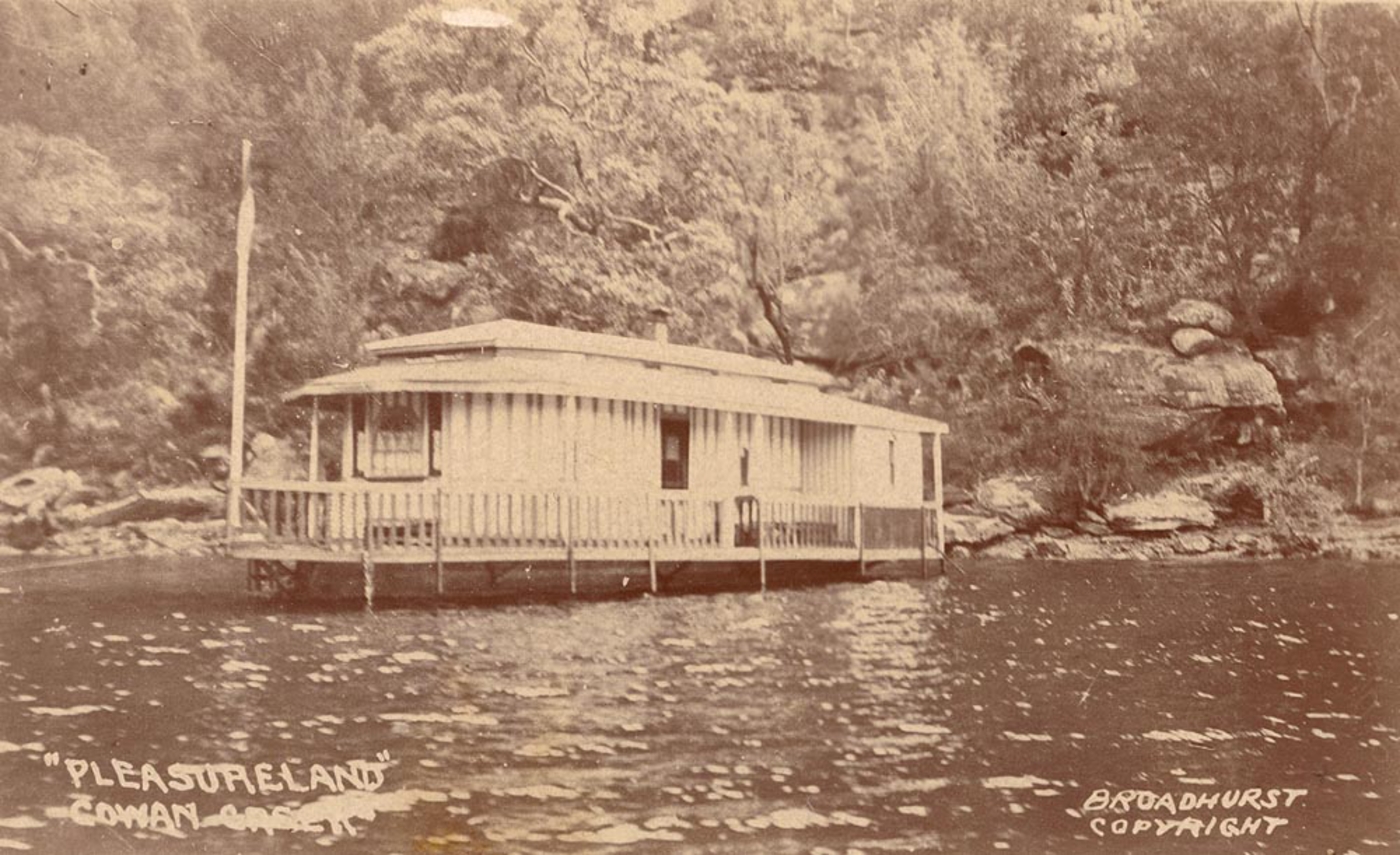
Windybanks Pleasureland houseboat, circa 1900. Image No.: a105189h, courtesy State Library of New South Wales.
However, when it came to having something of this size permanently on the Pittwater estuary itself, saving these classic old ships from the ship-breakers was no easy task. One early attempt, using a former Pittwater Regatta flagship, met with fierce opposition from residents and the then flegdling Royal Motor Yacht Club of Broken Bay (at Newport), as this article from months before the 1929 Wall Street crash explains:
Famous Old Paddle Steamer May Become "Gentlemen’s Club"
GALLEON AHOY! INVASION OF PITTWATER
Drake stooped to finish his game of bowls when the Spanish Armada hove across the horizon..
With a Spanish galleon threatening the serenity of Pittwater, some of the residents of Newport and Bay View, and the local branch of the Royal Motor Yacht Club refuse to adopt any such wait-and-see policy. They are out to rake the galleon through with the chain shot of diplomatic objections to the Navigation Department' before she is fairly built.
But if plans succeed, a graceful, three-masted ship of 1251 tons register, and 350 feet long, will be towed through the Hawkesbury inlet and down to Bay View in the near future.
THE Innocent source of the trouble that is brewing is the old paddle-wheel steamer Newcastle, lying in Iron Cove, and destitute of engines and boilers. But a great future has been mapped out for her. Mr. G. D. Morel is the originator of the plan, and he claims that it is going to add considerably to the fame and prosperity of Newport. He has long thought that jaded Sydney men of the right type need few things more than a flopping club in picturesque surroundings to set them up each weekend for the coming week's work. And the Newcastle has been chosen for this purpose. Plans have been prepared by the architect, Mr. A. Douglas Smith, and the structure of the boat naturally suited the idea of a Spanish galleon. Extensive alterations, costing £8000 to. £10,000, will have to be carried out, and the club, when it is towed to its anchorage at Pittwater will have cost between £12,000 and £14.000. The bulge of the paddle-wheels on each side will be converted .Into two pleasing and almost semi-circular balconies,- a pontoon being placed below the port side, with steps leading on to the balcony. There will be an imposing portico, leading into a hall, and guests who come on board late at night will find the secretary asleep but ready for business in his bedroom off this' main hall. '
SWIMMING TANK
Forward from the hall (on the plans) is an immense lounge, 51 by 32 feet, and beyond that a dining-room 62 by 32.' Above the lounge and dining-room are big promenade decks — below, where the engines and boilers were, is a big storage area for fresh water, and a swimming pool, 33 by 25 feet. It is fed from the sea and emptied by intake and outlet valves. The whole after-part of the ship, four decks high, is to be made into staterooms, with accommodation for 100 guests. At night the vessel will be a blaze of lights.
'DRY" ship
Mr. Morel states that the galleon will be a dry ship. No attempt is going to be made to take out a liquor licence for the club, which will set out to secure 300 or 400 members. They will be carefully chosen, and undesirables will be rigorously excluded, for, if the club got a bad name for drinking or gambling, her mooring licence would be quickly suspended- by the Navigation Department. No expense is being spared, hi the plans at least, to make the vessel luxurious, inside and out.
THE OPPOSITION
From these specifications, one would think that almost any watering resort would be anxious to lure the galleon to port, but the Bay View and Church Point Progress Association and the Pittwater branch of the Royal Motor Yacht Club regard her with sceptical eyes. They are shoulder to shoulder in opposing the scheme. ‘'We cannot get a liquor license ourselves," said the commodore of this branch of the Yacht Club (Mr. A. C Cooke) . "Yet it seems that it may be easier to get a license for the Newcastle, because she will be on the water, and not on any road or highway."
He says that the fairway at Newport is very restricted, and he understands that the Newcastle is to be moored 100 yards off Newport jetty, which would practically block the approach to the wharf. Mr. Morel, however, says that the boat will be moored much further out, and nearer to Bay View and Church Point than to Newport.
"We have-not heard how the promoters of the scheme propose to dispose of their garbage and sewerage but this again is ground for objection " said Mr. Cooke. (The plan provides for a big septic tank Inside, the vessel.)
"It is proposed to make the boat a gentlemen's club, and we say that this means that it will be a drinking and gambling resort," he continued: "Even If the boat Is refused a liquor license, that will not stop the drinking, for members will take their own supplies on board. We own a valuable property in Newport, and the idea is not fair to us or to any other owners of property there."
Mr. N. — Routley, the secretary of the Yacht Club, says that there is at least a chance that the floating club will not pay, and that it will fizzle out after the Newcastle is established there.
"She is in such a condition that, personally, I do not think they will be able to float her round there." he said. "If they do, and the club is a failure, will it be left to the residents of Newport to get rid of her?"
The secretary of the Progress Association (Mr. A. J. Sachs) also contends that it will not be fair to Newport ratepayers if the Newcastle is dumped at its doorstep. The association is treating with the Navigation Department to put a stop to the scheme. Mr. Morel has no doubt about the Newcastle's seaworthiness for the short trip. The marine surveyor's report recommends docking and painting, but declares the Newcastle's hull in sound condition, and that after the docking she will not require further attention for several years. Famous Old Paddle Steamer May Become "Gentlemen's Club" (1929, January 13).The Sun (Sydney, NSW : 1910 - 1954), p. 6. Retrieved from http://nla.gov.au/nla.news-article230373677
From Paddle Boat to Club
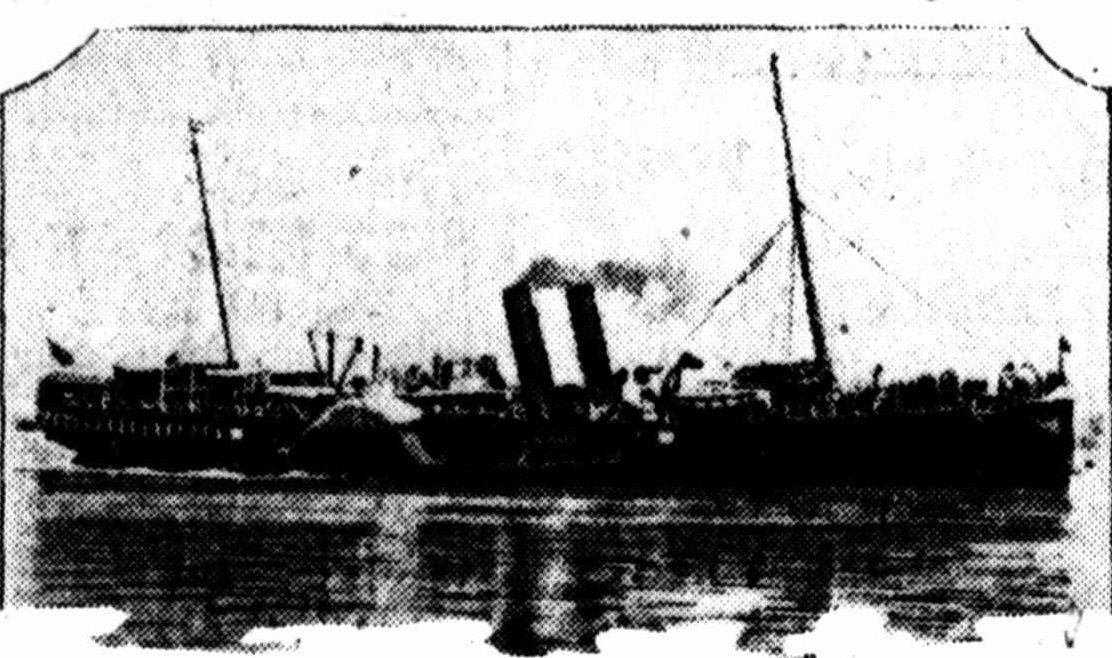
The old paddle-steamer Newcastle now lies in Iron Cove awaiting the start of the job of transferring her into a gentleman's club.
The "Gentlemen's Club"
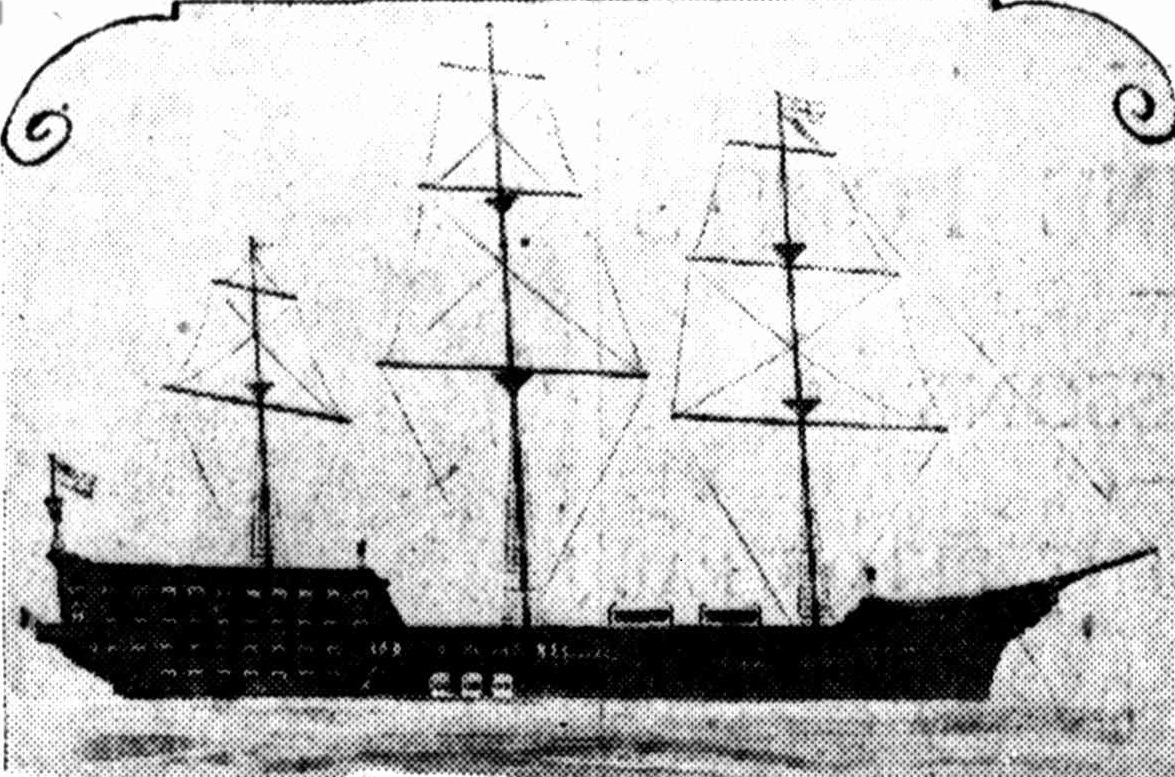
How the old S.S. Newcastle will look when turned into a gentleman's club— a floating clubhouse in the style of a Spanish galleon. From Paddle Boat to Club (1929, January 13). The Sun (Sydney, NSW : 1910 - 1954), p. 6. Retrieved from http://nla.gov.au/nla.news-article230373676
The S.S. Newcastle was the last ocean going paddle steamer actively working until being withdrawn from the seas and being hulked in 1928. She was launched in 1884 - a little abouit those early years:
LAUNCH ON THE S.S. NEWCASTLE. Yesterday afternoon (says the Scotsman of August 22) there was launched from the Kinghorn shipbuilding yard a large paddle steamer intended for the Australian coasting trade. The vessel has been built to the order of the Newcastle Steamship Company, Limited, Sydney. The steamer is superbly fitted out for the trade, being equipped with all modern appliances. Her passenger accommodation is of the most complete description and provides for 230 first-class and 170 second-class passengers.
On leaving the ways the vessel was christened "Newcastle." The following are her dimensions:-Length between perpendiculars, 200 feet breadth between paddles, 32 feet 6 Inches ; depth of hold to main deck, 10 feet 4 inches main deck to upper, 8 feet. She has a load draught of 11 feet. Her engines are on the compound vertical oscillating principle with high pressure cylinder, 51-inch diameter, and 10 pressure cylinder, 100-Inch, with a 8-inch strokle. idle is to have four boilers, two double-ended and two single-ended. The vessel was taken in tow to Lietth, where she will be fitted out for sell. Private advisers state that the Newcastle will leave for the colony next week. LAUNCH OF THE S.S. NEWCASTLE. (1884, October 8). Newcastle Morning Herald and Miners' Advocate (NSW : 1876 - 1954), p. 2. Retrieved from http://nla.gov.au/nla.news-article135854545
THE S.S. NEWCASTLE.
The Newcastle Steamship Company’s new paddle steamer Newcastle, built by Messrs. John Key and Sons, of Kirkcaldy, went on her trial trip in the Firth of Forth last month. The Glasgow Herald" says:--" The weather was very Stormy, but the Newcastle steamed out the Firth past Inchkiesh. On resuming against the wind one of the journals of the engines became heated, and a stoppage was made till it had been cooled by water. The steamer then returned to Granton Harbour, and dinner was served in the saloon-Captain Anderson presiding. Among those present were Mr. Harley, Mr. George A. Key, Mr. A. Key, Mr. Henry Barnet, Mr. Grieve, Glasgow; Mr. Henry M'Nab, London; Mr. Norman, New South Wales; Captain W. Anderson, Mr. Matthews, and Messrs. Darling and Paulsen, Lloyd's surveyors.
Owing to the state of the weather no trial of speed was made, but it is expected that the vessel will run over 16 knots. all hours. She at all events showed herself a good sea boat."
Private advices state that, in consequence of a heated bearing, and a gale of wind blowing, the Newcastle was only driven on her trial trip at moderate speed, and that the engines made 25 revolutions with .5lbs steam and 26 ii vacuum, and that there is no doubt she would attain on her station a speed of at least 16 knots under fullsteam of 1001b., which will be easily maintained, owing to the exceptionally large bailers. The Newcastle was cabled from Suez last week, where she arrived on Thursday morning, having encountered strong head winds and high seas in the Mediterranean, and also had detention in the canal. THE S.S. NEWCASTLE. (1884, December 18). Newcastle Morning Herald and Miners' Advocate (NSW : 1876 - 1954), p. 2. Retrieved from http://nla.gov.au/nla.news-article135856676
Newcastle S.S Company's Steamer
COOKTOWN, Monday, 4 p.m.-The Newcastle Steamship Company's new steamer Newcastle arrived at Thursday Island on Saturday, all well. She is now taking in coal and will leave to-day for Sydney. Newcastle S.S. Company's Steamer Newcastle. (1885, January 20). Newcastle Morning Herald and Miners' Advocate (NSW : 1876 - 1954), p. 2. Retrieved from http://nla.gov.au/nla.news-article139066368
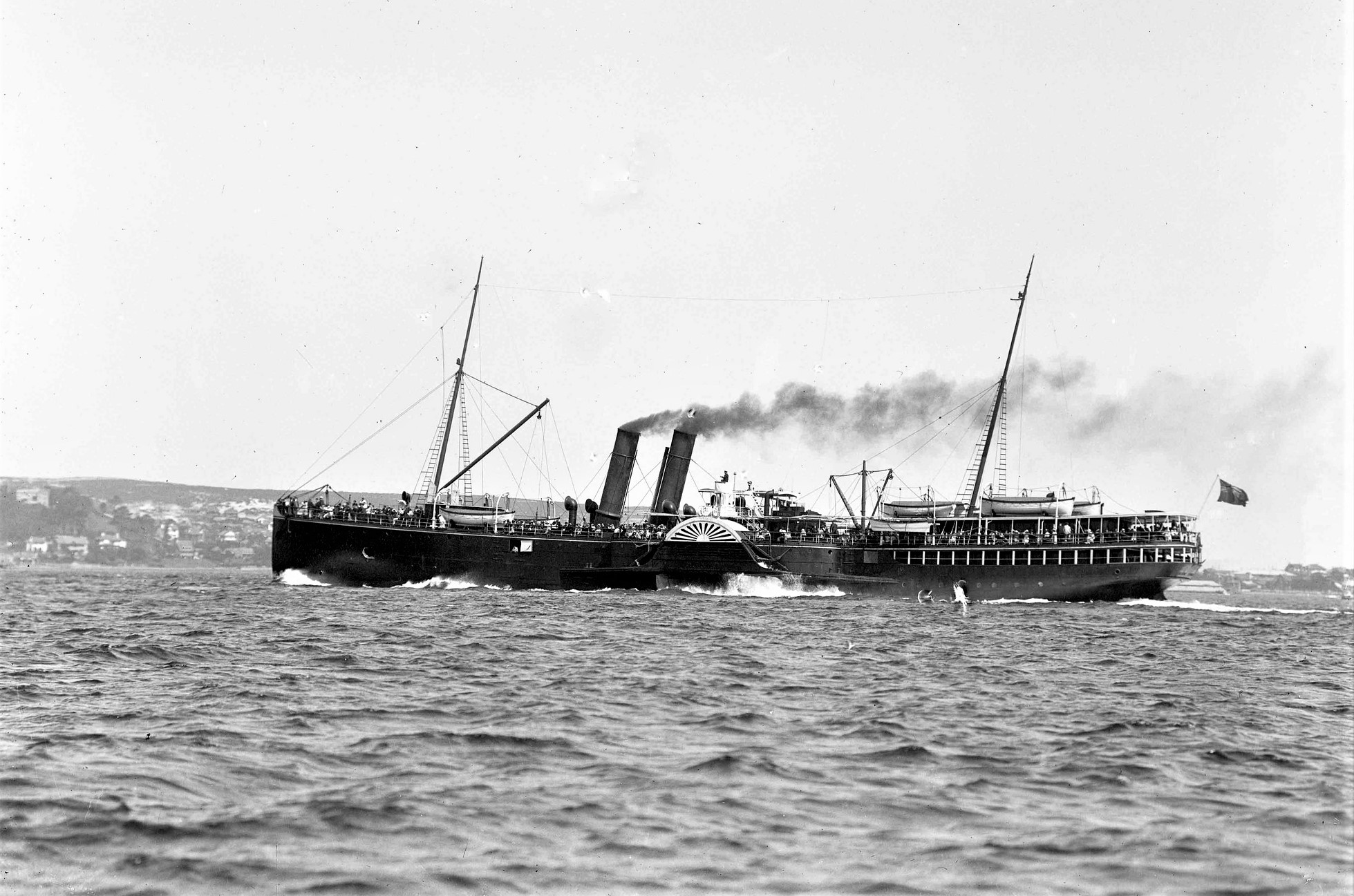
Paddle steamer NEWCASTLE, Sydney Harbour - from and courtesy Australian National Maritime Museum’s William Hall collection (on Flickr). Object number: ANMS1092[069]
THE S.S. NEWCASTLE.
Yesterday afternoon the Newcastle Steam Shipping Company's magnificent new steamer Newcastle arrived here, and berthed at the steamers wharf. The vessel was some months ago ordered by the company from Messrs. John Key and Sons, of Kircaldy. Captain Anderson, the company's superintendent, was sent home especially to supervise her construction, and has brought out one of the most magnificent vessels that ever come to the colonies. The chief aims in her construction were staunch build, swift speed, and accommodation to surpass any of her predecessors. In this respect she is more than a success, for she may be safely termed a “floating palace." The vessel is of course intended to run between Newcastle and the metropolis, and according to her trial trip, will beat everything put before her for speed. During her stay in Sydney she has been at Mort's Dock undergoing the usual overhaul accorded to vessels after a long voyage. The hull has been thoroughly cleaned and painted, cabins, saloons, and all the passenger accommodation renovated. Various alterations and improvements have been effected to make her better adapted for this trade, and with such a popular skipper as Captain Adams at the head of affairs, She is sure to become a favourite among the travelling public. She was floated out of dock on Thursday, and afterwards swung, and had her compasses adjusted.
Yesterday morning the vessel proceeded down Sydney harbour on at trial trip, when the measured mile was run in three minutes forty seconds (being at the rate of nearly nineteen miles an hour), the fastest record of time ever accomplished in the colony. The trial was made under very unfavorable circumstances, the vessel being considerably cut of trim.
During the trip a number of directors and their friends were on board, and expressed themselves delighted at the magnificent result of the trial. Champagne was opened, and a number of friendly toasts proposed. She left the Sydney wharf at ten minutes to one on her initial voyage to the port from which she is to hail, having on board a large number of people, among them being directors, shareholders and others interested in the progress of steam navigation in these waters. She rounded North Head in twenty-seven minutes from the time of leaving the wharf; but when outside, off Manly Beach, owing to the disarrangement of the circulating pump, she had to be stopped for twenty minutes to disconnect one of the small engines. The voyage was resumed at sixteen minutes to 2, and good progress was made, the vessel easing off at Nobbys at sixteen minutes to 5. the actual sea passage being thus accomplished in four hours.
The behaviour of the vessel as a sea boat was the theme of general comment and pleasure by all on board ; and those who travelled by the Kembla state the motion in the Newcastle is even easier and more pleasant. The passage would probably have been still more rapid one, only that the coal used on the trip was the balance of that taken on at Thursday island (Bulli coal), which for the purposes of generating steam, is not to be compared with that of Newcastle. But even under those circumstances the trip, we understand, was the quickest on record. The interest in town to see the latest addition to our steam fleet almost bordered on excitement, and when the Newcastle came alongside there were several hundred people on the wharf anxiously awaiting her arrival. As soon as the gangway was passed ashore crowds poured on board, and the steamer was soon thronged in every portion by sightseers, who expressed unbounded admiration at the beauty and completeness of her general fitting up.
The SS Newcastle commenced her "trade " last night, leaving at 11 o’clock, with a crowd of passengers.
On Monday next she will make an excursion outside the harbour, when, by the courtesy of the directors, there will be a large number of visitors on board from Newcastle and the neighbourhood.
One of the gentleman who made the trip in her yesterday, writes :-She was under steam four hours and thirty-two minutes, starting from the wharf at Sydney to Nobbys. She left at twelve minutes to 3, and reached Nobbys at forty-two minutes past 5. Out of that time she was stopped for twenty minutes owing to some overheating in the machinery. As she only had coal in her from Thursday Island, which had been exposed to the air, no doubt for months before she got it, the speed of the boat as far as can be ascertained, will average four hours from port to port, or about four hours and twenty minutes from wharf to wharf without pressure. Of course to put to her full steam, she would go much faster. We congratulate the Newcastle S.S. Co. upon such a magnificent addition to their fleet. A full description of this magnificent specimen of marine architecture has already appeared in our columns. THE S.S. NEWCASTLE. (1885, February 14). Newcastle Morning Herald and Miners' Advocate (NSW : 1876 - 1954), p. 4. Retrieved from http://nla.gov.au/nla.news-article139074450
Of course, any steamer travelling up and down the coast between Sydney and Newcastle was subject to running into another steamer, doing the same route, and one of the steamers that would also serve as a flagship for Pittwater Regattas:
COLLISION BETWEEN THE S.S. NEWCASTLE AND NAMOI. MARINE BOARD INQUIRY.
An inquiry was held yesterday morning by the Marine Board into the circumstances connected with the collision which occurred, between the coasting steamers Newcastle and Namoi, on the morning of the 12th instant, when running between Sydney and Newcastle. There were present :-Captain Broomfield, vice-president (in the chair),Captains Jenkins, Moody, M'Lean, Robertson, and Captain Lindeman, secretary. Mr. J. Want, instructed by Mr.O'Keefe, appeared on behalf of the owners of the Namoi and Mr. Rogers, instructed by Mr. Wallace, for the owners of the Newcastle. The following evidence was given :
Captain W. A. Knowles, sworn, stated that he was master of the Namoi on the morning of the 12th instant when she came into collision with the Steamer Newcastle; the Namoi was a paddle steamer, owned by the H. R. N. S. N. Company, and registered in Sydney ; she was not insured at the time of the collision the, Namoi was on a voyage from Sydney to Newcastle, and the collision occurred a little north of Cape Three Points ; the Namoi was not seriously injured ; there was a very thick fog at the time.
To Mr. Want : We left Sydney Wharf at 11 p.m., and got to the point of collision at 2 a.m. ; the fog came on a little after 1 o'clock, and he was then about two miles north of Broken Bay light ; the fog was then beginning to obscure the light, and ho slowed the engine ; the vessel could not have been going at the rate of five knots an hour; it was impossible for the vessels to have seen one another before they did; sometimes his masthead light was obscured ; he blew his whistle four seconds before the Newcastle did ; the Newcastle was nearly end on, but, judging by the sound, a little on the port bow ; lie gave the order to port, believing that the vessels would thus pass port to port ; he then blow the long blast in answer to the long blast from the Namoi, and immediately afterwards two blasts came from the Newcastle, showing that she had starboarded ; it was impossible for him to starboard then, as his vessel was paying off ; he then stopped his vessel and heard the relief officer of the Newcastle call out "Go astern; " the Newcastle was heading to his fore rigging, and would therefore have struck the Namoi's fore cabins; witness ordered "full speed," as loss of life might have ensued if the Newcastle had cut into the fore cabins, and she had been blowing the whistle for some time before the collision occurred ; he had never seen the fog so dense before except on oo ; his vessel was heading north by east half east when he heard the whistle, and east north-east at the time of the collision ; there was a man on the look-out on the starboard paddle-box ; the second officer on the port, and there were also himself and the man at the wheel Frederick Dettman, second officer of the Namoi, deposed that he remembered the fog coming on, the vessel somewhere about Broken Bay at the time, and the speed was put to slow, this would reduce the speed to five or six knots there was a good lookout, but it was hardly possible to see the vessel a length ahead, the whistle was kept going, he heard a whistle on the port side, and north ahead, just before the collision Captain Knowles gave the order, laid a-port, and the Newcastle blew her whistle for starboard, as the vessels were coming together if Captain Knowles had not given the order full speed ahead, the Newcastle would have shuck the Namoi amongst the fore cabins, the blow came on the sponsons from the time the Namoi whistle gave one blast until ho heard two from the Newcastle only a few seconds elapsed….. The board, having carefully considered the evidence adduced in the case of the collision between the steamers Namoi and Newcastle, are that it was caused by a very thick fog, which Prevented the vessels being seen in time to avoid the collision, and no evidence has been adduced on which to found a charge of default against either master. At the same time the were of opinion that, if the Namoi had gone full speed astern, the collision would have been avoided. COLLISION BETWEEN THE S.S. NEWCASTLE AND NAMOI. (1886, February 19).The Sydney Morning Herald (NSW : 1842 - 1954), p. 4. Retrieved from http://nla.gov.au/nla.news-article13611830
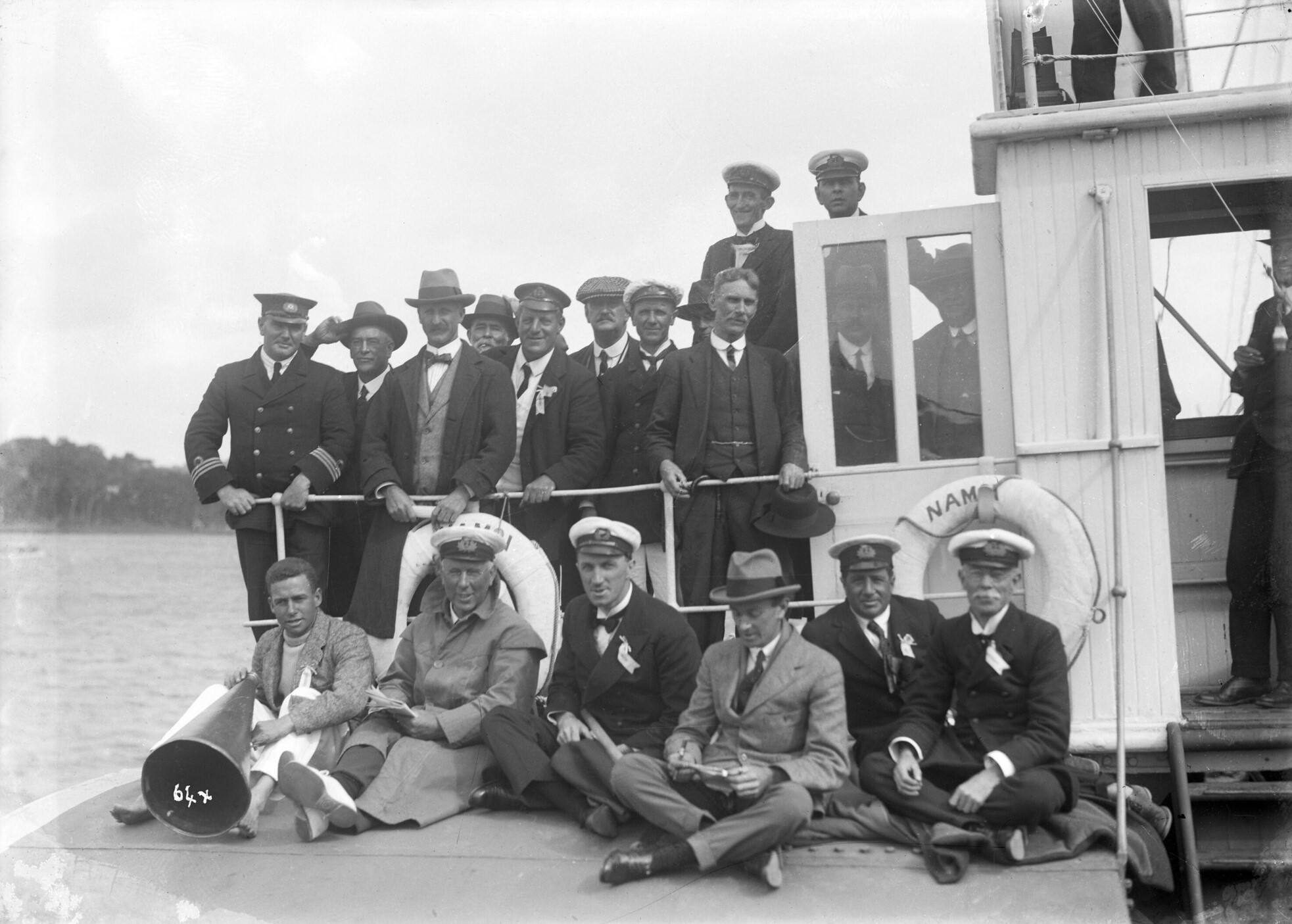
Crew and officials of the Pittwater Regatta on NAMOI, photo is part of the Australian National Maritime Museum’s William Hall collection, Object no. 00012165
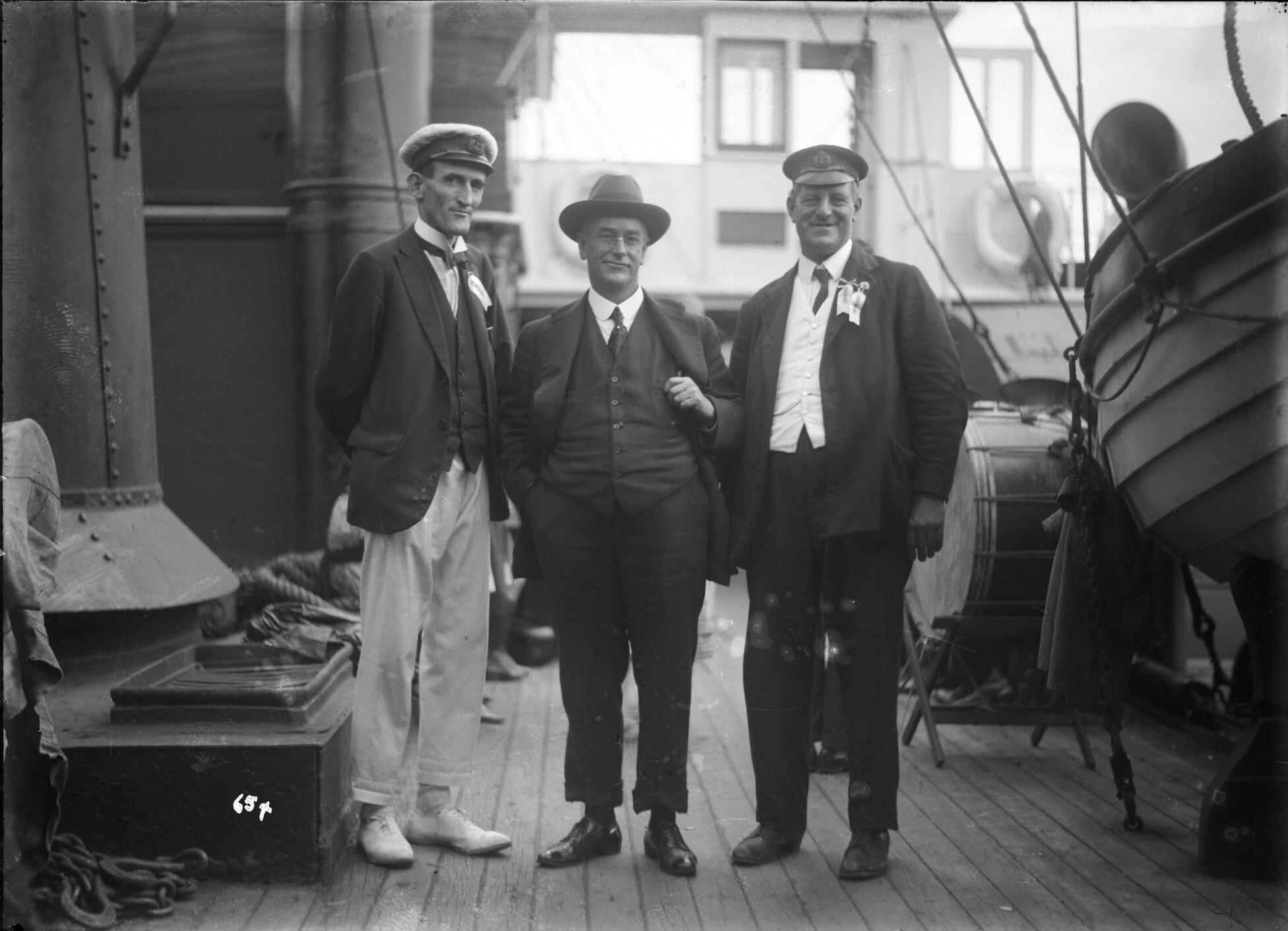
Mr John Roche (left), Mr F. J. S. Young (had land at Church Point - Bayview) (right) and an unidentified man onboard NAMOI at Pittwater Regatta, photo is part of the Australian National Maritime Museum’s William Hall collection, Object no. 00012166
The worldwide and Australian financial Depression as well as local opposition put paid to the old paddlesteamer becoming a local floating 'gentlemen's club' and she was scuttled in 1933, her fellow steamer Namoi scuttled a few weeks later:
NEWCASTLE SCUTTLED.
Last of Famous Paddle-steamer.
Sydney saw the last of the famous paddlesteamer Newcastle early yesterday morning, when the stripped hulk was towed 15 miles to sea by the fireboat tug Hydra, and scuttled.
Built In 1884, at Kinghorn, Firth of Forth, for the Sydney-Newcastle trade, at a cost of approximately £60,000, the Newcastle, with a speed of 19 knots, was then one of the speediest vessels in the Australian coastal trade. She was a handsome craft, with three funnels and large paddle wheels, and the steam necessary to create her propulsion capacity of 737 horse-power was generated by six boilers. 'She had accommodation for 350 passengers, and her gross tonnage was 1251.
She ceased regular service less than 11 years ago, and was a stand-by steamer until 1923.
On one occasion more than 40 years ago she ran under charter to Huddart, Parker, Ltd., in the Melbourne-Launceston trade. In August, 1928, her owners, the Newcastle and Hunter River S.S. Co.. Ltd., sold her to shipbreakers. NEWCASTLE SCUTTLED. (1933, June 2).The Sydney Morning Herald (NSW : 1842 - 1954), p. 13. Retrieved from http://nla.gov.au/nla.news-article16958893
Old Steamer On Last Voyage
In tow of the tug Hydra, the former paddle steamer Namoi was today taken outside Sydney Heads and scuttled. Built in 1883, the vessel, of 809 tons, was well-known in the Sydney-Newcastle trade for many years, running in conjunction with the Newcastle, which was also scuttled recently. Old Steamer On Last Voyage (1933, June 16). The Sun (Sydney, NSW : 1910 - 1954), p. 13 (FINAL EXTRA). Retrieved from http://nla.gov.au/nla.news-article228899420
The 1930's didn't lend themselves to floating hotel enterprises and then World War II, and the defence of Australia's coasts, meant a closed off Pittwater estuary and the suspension of aquict events such as the by then very popular Pittwater Regatta.
This conflict also saw a lot of ship building taking place locally, including the Fairmile B class motor launch. This craft was built for use by Britain's Royal Navy, the Free French Navy, Royal Canadian Navy, Royal Indian Navy, Royal New Zealand Navy, Royal Norwegian Navy, Royal Hellenic Navy, US Navy and the Royal Australian Navy.
Named for the British Fairmile Company that designed them, Fairmile motor launches were small, fast, highly manoeuvrable, lightly armed ships. They were originally intended to be used for coastal anti-submarine and convoy protection duties but soon proved to be vessels capable of much broader operational tasking.
In April 1941 the Royal Australian Navy (RAN) recognised the need for a vessel which could be built locally and used in the littoral waters of Australia, New Guinea, the Dutch East Indies and their surrounding islands. On January 5th 1942 the War Cabinet gave approval to construct Fairmiles in Australia. Between November 1942 and April 1944, thirty five vessels were commissioned into RAN service.
Although some were built by Lars Halvorsen & Son, Sydney, at least 20 Fairmile B motor luanches were built at the Green Point Naval Boatyard, which was established at Mortlake NSW during World War II down at Mortlake Point on the Parramatta River. The facility built and serviced mainly Fairmile motor launches and GPVs (General Purpose Vessels) for the Australian Army, Navy and US forces. It continued in operation after the war until the mid 1950s.
In Australia 35 Fairmile boats entered service from October 1942, most of them unnamed but with HMAS ML and gthen the number of the vessel, for example: HMAS ML808. They were employed on routine patrols, convoy escorts, running special forces in and out of Japanese-held areas, boom defence patrols in harbours at home and abroad, courier operations, survey work, and raiding Japanese-held coasts.
After peace reigned again many of these were surplus and sold off where they converted for use as ferries, fishing vessels and even luxurious cruisers for private use, especially the Fairmile B class. Their dimensions and ease of conversion made them a popular item in an Australia still short on a lot of materials for post-war boom build times. They were snapped up at bargain rates and one appears here, in Pittwater, as:
EX-NAVY BOAT FOR CRUISES
Six young men, at Rose Bay are converting into a pleasure boat. a. £50,000 Fairmile Navy patrol boat which they bought at a disposal sale for less than £500. They are working in their spare time and do not expect to finish the conversion for another year.
They are: Mr. T. Fairweather, city businessman; Mr. L. J. Smith, Lakemba commercial traveller; Mr. A. Audet, Marrickville engineer; Constable A. Clark, of Bondi; Constable A. Lake, of Earlwood; and Mr. F. Dries, Campsie electrician.
Mr. Smith said yesterday: "These Fairmiles, which cost the Government £50,000 each to build, went for between £150 and £500 each at disposal sales.
"We bought ours last October. We paid ! more than £150, but less than £500. "Already we have sold about £80 worth of scrap brass. .
"We have fitted two powerful diesel engines which were salvaged from a sunken landing barge.
"Very Cheap"
"We got these very cheap because everyone else thought that the immersion had damaged them."When "When we have finished the boat we'll take- our holidays together and, go for a fortnight's cruise."Then "Then we'll decide whether to sell it or not. "It should be worth at least £5000."
Lars Halvorsen and Sons Pty., Ltd., are reconverting another Fairmile at their Neutral Bay shipyard for the managing director of Standard Waygood; Ltd. (Mr. D. T. Nicholson). Other shipwrights are converting a Fairmile in Black-wattle Bay.
A family at The Basin (Broken Bay) and two other families at Lake Macquarie are using Fairmiles as houseboats. EX-NAVY BOAT FOR CRUISES (1948, July 6). The Daily Telegraph (Sydney, NSW : 1931 - 1954), p. 7. Retrieved from http://nla.gov.au/nla.news-article248387760
Soon afterwards the Fairmile at The Basin was put up for sale:
"The Capricorn" - Floating Hotel
COASTERS RETREAT PITTWATER- VACANT POSSESSION OF THIS HOTEL AFLOAT is offered together with all Furniture and Fittings Moored In pleasant COASTERS RETREAT Pittwater the vessel was constructed for the Commonwealth Government of the FINEST TIMBER available as motor torpedo boat It has been DELIGHTFULLY FURNISHED and refitted with every MODERN AMENITY Including shower-rooms and toilets The LOUNGE Saloon Is fitted with a most attractive COCKTAIL BAR and SLEEPING facilities include spacious 2 berth deck cabins FOR. FULL PARTICULARS APPLY OFFICE OF AUCTIONEERS. Solicitors LORTON DUKE & CO. Advertising (1950, February 11). The Sydney Morning Herald (NSW : 1842 - 1954), p. 22. Retrieved from http://nla.gov.au/nla.news-article18143807
This advertisement after the preliminary one run above shows the profit margin hoped for, an earlier listing in January 1950 saw one Fairmile put up for sale, once converted, for £7,500.00:
"The Capricorn" - Floating Hotel
COASTER'S RETREAT-PALM BEACH.
VACANT POSSESSION OF THIS HOTEL AFLOAT is offered, together with all furniture and fittings. Moored in pleasant COASTER'S RETREAT, Pittwater, the vessel was constructed for the Commonwealth Government of the FINEST TIMBER, at a cost of £33,000, and was known as "FAIRMILE" No. 808. It has been DELIGHTFULLY FURNISHED and refitted with every MODERN 'AMENITY. Including shower-rooms and toilets. The LOUNGE Saloon ls fitted with a most-attractive COCKTAIL BAR and SLEEPING FACILITIES Include spacious 2-berth deck cabins.
INSPECTIONS BY APPOINTMENT ONLY. FOR FULL PARTICULARS APPLY OFFICE OF AUCTIONEERS. Solicitors: LORTON DUKE & CO. Advertising (1950, March 11). The Sydney Morning Herald (NSW : 1842 - 1954), p. 24. Retrieved from http://nla.gov.au/nla.news-article27575889
Fairmile HMAS ML808 was built at the Green Point boatyard and served in New Guinea:
NAVAL SUPPORT AT WEWAK
R.A.N. Decorations
Naval support for the Australian Army assault on Wewak is recognised in a list of decorations issued by the Navy Office, Melbourne. yesterday. The recipients were in small ships, H.M.A.S. Swan, sloop; H.M.AS SS Dubbo, Deloraine and Colac, corvettes, and Fairmile motor launches, Nos. 427, 804, 808, 811, 816 and 820. These ships supported the 6th Division, A.I.F., in its advance along the coast from Aitape to Wewak.
The Fairmiles carried out intensive sweeps during the dark hours, drawing the fire of the Japanese positions, which were pin-pointed. Swan and the corvettes took up the attack with 4-inch fire in daylight. Lieutenant' W. J. Dovers, R.A.N., commanding officer of H.M.A.S. Swan, has been awarded, the D.S.C., and the naval officer in charge. New Guinea, Captain J. C. D. Esdaile, R.A.N. . now, Controller of Naval Demobilisation, who controlled the operations, has been mentioned, in despatches. Lieutenant (Sp.) H. L. Billman, R.A.N.R,, who has been previously mentioned in despatches, has been awarded the D.S.C. for his, work as a member of the Mobile Explosives Investigation Unit, which was responsible for neutralising unexploded bombs and mines in the Philippines campaign. NAVAL SUPPORT AT WEWAK (1945, November 9). The Age (Melbourne, Vic. : 1854 - 1954), p. 2. Retrieved from http://nla.gov.au/nla.news-article205653753
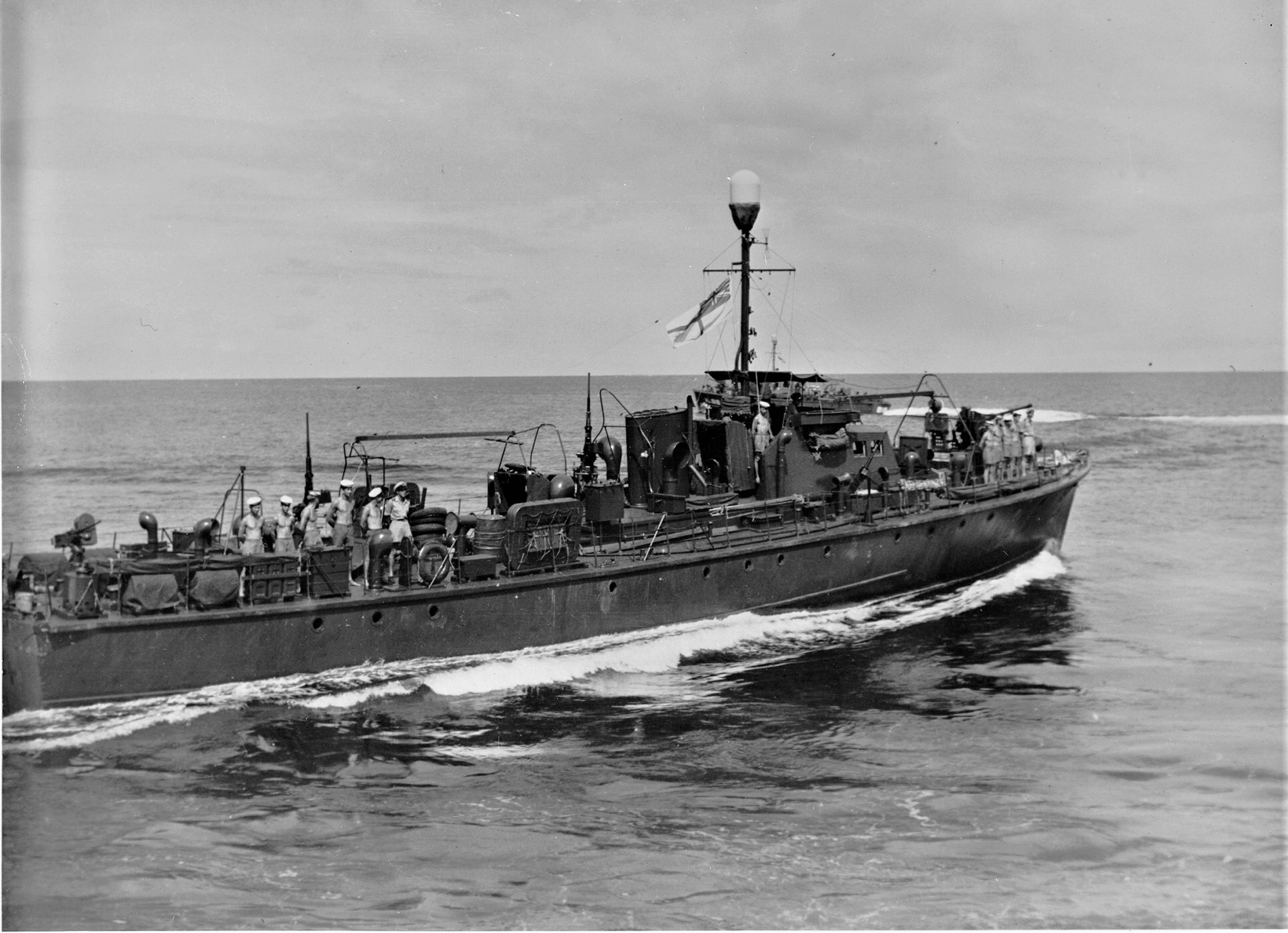
Circa. 1945: Fairmile B motor launch ML820 leaves port, crew dressed for New Guinea - this image may date from the period when ML820 was one of five RAN Fairmiles attached to Wewak Force, supporting the Australian 6th Divisions advance on the Japanese headquarters stronghold in northern New Guinea, and the Division's landings there on May 11, 1945. If you look closely you can see another 75 tons [standard] Fairmile Type B patrol launch. Photo: RAN, Navy Heritage Collection, image NO. 03635.
The Capricorn wasn't the only Fairmile seen on Pittwater during that post-war era:
Back from Palm Beach ... lunching together on Tuesday at Romano's were Mrs. Bill Adams and her future sister-in-law, Janet Rowland Smith . . . Mr. and Mrs; Adams have just returned from a six-weeks holiday at Palm Beach and Mrs. Adams is finding the hard pavements and' high heels quite a strain after so long of sand and sandals . . . last Sunday her two brothers Harold and Neville Bishop, were hosts aboard their newly decorated Fairmile "Ajax" now anchored, in Pittwater, where they entertained 36 guests with drinks and a cruise to Refuge Bay. AROUND THE TOWN (1952, February 14). The Daily Telegraph (Sydney, NSW : 1931 - 1954), p. 16. Retrieved from http://nla.gov.au/nla.news-article248778201
The Fairmiles weren't the only 'floating villas' proposed to be seen on Pittwater. One last classic beauty was also temporarily slated to be heading here:
WEEROONA FOR SALE
The 40-year-old paddle steamer Weeroona, and former Port Philip Bay pleasure ship, will be sold by auction in Sydney on July 5. Before she left Melbourne in 1945, the Weeroona carried more than a million passengers on 130,000 miles of bay cruising for her owners, Bay Steamers Pty. Ltd.
The U.S. Navy then towed her to Manila Bay, and fitted her out as a luxury rest ship. Her war service over, the Weeroona was taken to Sydney Harbour, and has since been lying at anchor in Iron Cove. Several prospective buyers proposed turning the veteran ship into a floating night club in the Harbour, or a holiday hotel at Pittwater or Port Hacking. The R.S.L. urged the Federal Government in 1946 to house homeless ex-servicemen in the old steamer. Of 1412 tons gross, the Weeroona was built at Pointhouse, Scotland in 1910. WEEROONA FOR SALE (1950, July 19). Daily Commercial News and Shipping List (Sydney, NSW : 1891 - 1954), p. 1 (Supplement to "Daily Commercial News and Shipping List."). Retrieved from http://nla.gov.au/nla.news-article163840567
The paddle steamer PS Weeroona was built by A. & J. Inglis, Pointhouse, Glasgow, Scotland and launched in 1910. She was initially owned by Huddart Parker Ltd, Melbourne and was one of several Port Phillip Bay excursion steamers operating out of Melbourne for day trips, excursions and picnicking to destinations such as Portarlington, Queenscliff and Sorrento. The excursion vessel was equipped as a luxury excursion ship capable of carrying 1,900 passengers.
During the 1925 visit of the American fleet the ship was involved in an incident described as "A gratuitous insult to the Prime Minister" when the ship's firemen went on strike with the Commonwealth Ministers and a thousand guests, including foreign consuls and military officers, aboard in protest of comments made by the Prime Minister and demanding he depart the ship, although he was actually not aboard. The firemen demanded a bond of £100 that he was not aboard, a demand rejected, and the trip was cancelled.
By 1932 the newer Weeroona was the only one of the line remaining in service due to increased land transport with Weeroona being purchased for war service March 17th 1942. An article of November 1st 1943 noting the steamer might not resume excursion service after the war mentions the company, Bay Steamers, was in liquidation and that the ship operated thirty-three years without a collision, that four of her captains had retired and died and that she had made 2,774 voyages, travelled 206,990 miles (333,120 km) and carried 3,030,508 passengers in that service.
Weeroona became part of the United States Army permanent local fleet under the Southwest Pacific Area command's supply organisation, United States Army Services of Supply, Southwest Pacific Area (USASOS SWPA), and was used extensively serving as a quarters ship for American maritime personnel. As part of the Small Ships Section the vessel was given the local fleet number S-195 and perhaps also as CSQ-1.
.png?timestamp=1589520355611)
Weeroona (S-195), Small Ships Section, United States Army Services of Supply, Southwest Pacific Area, 1943. Photo by United States Army Signal Corps - The steam ship Weeroona (S-195) of the Small Ships Section, United States Army Services of Supply, Southwest Pacific Area (USA SOS SWPA), docked at an unidentified wharf, probably in Sydney. The Weeroona was acquired from Bay Steamers, Melbourne, Vic, on 17 February 1943, and served as a quarters ship for crew members in Sydney and New Guinea. Initially Australian ships were requisitioned and chartered for the Small Ships Section. Construction of ships for USA SOS SWPA commenced in Australia in 1942. Approximately 3000 vessels were constructed, including freighters, launches, tugs, towboats, lighters, rescue and salvage boats and a large number of barges. An additional 4000 lifeboats and dinghies were built.
Around 3000 Australians enlisted in the Small Ships Section during the Second World War. They were not inducted members of the US Army, but were civilians attached to the Army. They were often too young, too old or physically ineligible to serve in the Australian armed forces.
The Weeroona was used as a quarters ship by Australian personnel under contract to the U.S. Army's Small Ships Section in Sydney and New Guinea. The ship was also used by U.S. Army Signal Corps personnel, some of whom were setting up small ships as communications ships, as barracks and dubbed CSQ for communications ship quarters. Weeroona was towed from New Guinea to the Philippines to support Allied forces there at Leyte Gulf and eventually serving as a barracks and convalescent ship in Manila until towed back to Sydney, where she lingered in the harbour until broken up in 1951.
Sizeable yachts and cruisers still visit Pittwater or are part of the permanent 'seascape' of the estuary, and one newly spotted item during the Spring of 2018 has also become a 'home away from home' for those who prefer a watery front and back yard view.
Officially launched in the Summer of 2018-2019, 'Lilypad' was designed by Chuck Anderson, who commenced as a metal fabrication apprentice at the Gonsalves Boatshed at age 19. He worked on classic boats as well as high-end homes in our area prior to designing innovative, sustainable solutions for a whole host of applications at his Little Mill business, from a bio-diesel processing plant to a replica WWII submarine.
The dream to enjoy Perfect Pittwater with nothing between your toes and the salty briny continues!
- TROVE - The National Library of Australia
- State Library of New South Wales
- Fairmile B Motor Launch,Wikipedia entry at: https://en.wikipedia.org/wiki/Fairmile_B_motor_launch
- Papers in Australian Maritime Affairs No. 25. Missing Pieces: The Intelligence Jigsaw and RAN Operations from 1939-71 Ian Pfennigwerth. 2008. Retrieved from: https://www.navy.gov.au/sites/default/files/documents/PIAMA25.pdf
Fairmile B motor launch: Class overview
Length: 112 ft (34 m)
Beam: 18 ft 3 in (5.56 m) except Canadian built at 17 ft 0 in (5.18 m) or 17 ft 10 in (5.44 m)
Draught: 4 ft 10 in (1.47 m)
Propulsion: Two 650 bhp (480 kW) Hall-Scott Defender petrol engines
Also at The Basin in 1950
Sydney, 5th May, 1950.
IT is hereby notified that, in accordance with the provisions of section 26 of the Crown Lands Consolidation Act, 1913, the Hon. Anthony Alexander Alam, M.L.C., is hereby appointed (in the place of the Hon. E. H. Farrar, M.L.C., retired) as a trustee of the Ku-ring-gai Chase, Hawkesbury River, area about 35,300 acres, dedicated 14th December, 1894, for Public Recreation, and the following additions thereto, namely:—3 acres 1 rood 20 perches at Towler's Bay, Pittwater, dedicated 12th January, 1934; 7 acres 1 rood and 15 acres at Coaster's Retreat, Pittwater, dedicated 2nd August, 1911; 42 acres 2 roods 7 perches at The Basin, Pittwater, dedicated 31st August, 1917; 3 acres 3 roods at Cowan, dedicated 24th May, 1935; about 980 acres at McCarr's Creek, dedicated 19th April, 1940; 21 acres 2 roods 16 perches at McCarr's Creek, dedicated 29th May, 1942; 1,150 acres dedicated 27th August, 1943; 40 acres, parish of Broken Bay, dedicated 21st April, 1944; about 1,650 acres at Terrey Hills, dedicated 27th October, 1944; about 90 acres at McCarr's Creek, dedicated 27th October, 1944; 422 acres 2 roods 10 ½ perches at West Head, dedicated 2nd November, 1945, for Public Recreation; 31 acres 2 roods 6 perches, parish of Narrabeen, county of Cumberland, dedicated 18th October, 1946, for Public Recreation; and 48 acres 3 roods perches at The Basin, Pittwater, dedicated 18th October, 1946, for Public Recreation. P. 49-9,433.
W. F. SHEAHAN, Minister for Lands. Government Gazette Appointments and Employment (1950, May 5). Government Gazette of the State of New South Wales (Sydney, NSW : 1901 - 2001), p. 1203. Retrieved from http://nla.gov.au/nla.news-article220100172
PITTWATER REGATTA.
GOOD SEAMANSHIP.
Notwithstanding the "hard" weather on Saturday the Pittwater Regatta proved a great success Al though the number of starters was reduced in some of the events, the skill and seamanship displayed by the competitors fully compensated the large number of spectators The s s. Newcastle acted as flagship, and the commodore, Mr H J S Young, the Vice commodore, Mr A Doesen and the hon secretary, Mr John Roche, were indefatigable in their attention to the guests.
Accidents were few. Several skiffs capsized, but the crews were quickly assisted by the numerous motor boats cruising about. In the All Yachts Hermione lost her mainmast; Magic, when in a very good position, split her mains and Oenone struck trouble with her mainsail when reefing, which prevented her starting.
Great admiration was expressed for the skipper and crew of the 14ft skid Polygon, which filled up just after rounding the flagship Her nippy crew were quickly over the side leaving one man on board to bail, and this strenuous Job was taken in turns by all the crew until the boat was clear of water and was able to continua the race After having lost about 15 minutes through filling up Polygon was less than 10 minutes astern of the winner of the race
The breeze came from the north and was of a shifty nature, veering between north and west, with exceptionally hard squall. At times there were patches of flat calms
The regatta dinner, held in the evening, was well attended by representatives of all branches of aquatic sports… PITTWATER REGATTA. (1923, January 1). The Sydney Morning Herald (NSW : 1842 - 1954), p. 2. Retrieved from http://nla.gov.au/nla.news-article16029053
PITTWATER
THE BIG REGATTA
Pittwater Regatta, which owes much of its popularity to the fact that since Its institution curly in the present century Its picnic spirit has been maintained, will be held on New Year's Day, -on the picturesque waters of the southern- arm of the entrance to the Hawkesbury, aptly named on the official programme as the "Aquatic Mecca." From a humble beginning this carnival has grown Into one of the most Important events of the year, mainly owing to the hard work of a band of stalwarts, who have been connected with the function from the outset. Prominent among these are Mrs. E. G. Greig, Messrs. F, J. S. Young, and John Roche, and the last-named has under-taken the onerous duties of honorary secretary to every regatta that has been held.
Followers of the sport will find plenty of amusement on the day, as 10 sailing events are set down for decision, in which 93 craft, ranging from the stately yacht down to the 12ft. dinghy, have been entered. Rowing events under the auspices of the N.S.W. Rowing Association number six, for which 25 scullers and crews have, boon nominated while the seven local rowing races has induced 3-1 entries. Motor craft, too, have been well catered for and four races will be held, for which 49 power craft have entered.
The flagship s.s. Newcastle, in charge of Captain T. W. Bunks, will do duty as flagship, and will he moored half a mile north of Bayview wharf. Transit to and from the flagship will be carried out by a service of launches from Newport and' Bayview wharves. Luncheon and refreshments will be obtainable on board, and the band of the N.S.W. Fire Brigade will render selections during the day. In connection with the regatta, an excursion trip will be run by the flagship leaving Sydney on Friday, December 31, at 3.30 p.m., and returning from Pittwater on Sunday, January 2, at 11 a.m. PITTWATER (1926, December 22). The Sun (Sydney, NSW : 1910 - 1954), p. 6 (FINAL EXTRA). Retrieved from http://nla.gov.au/nla.news-article224129873
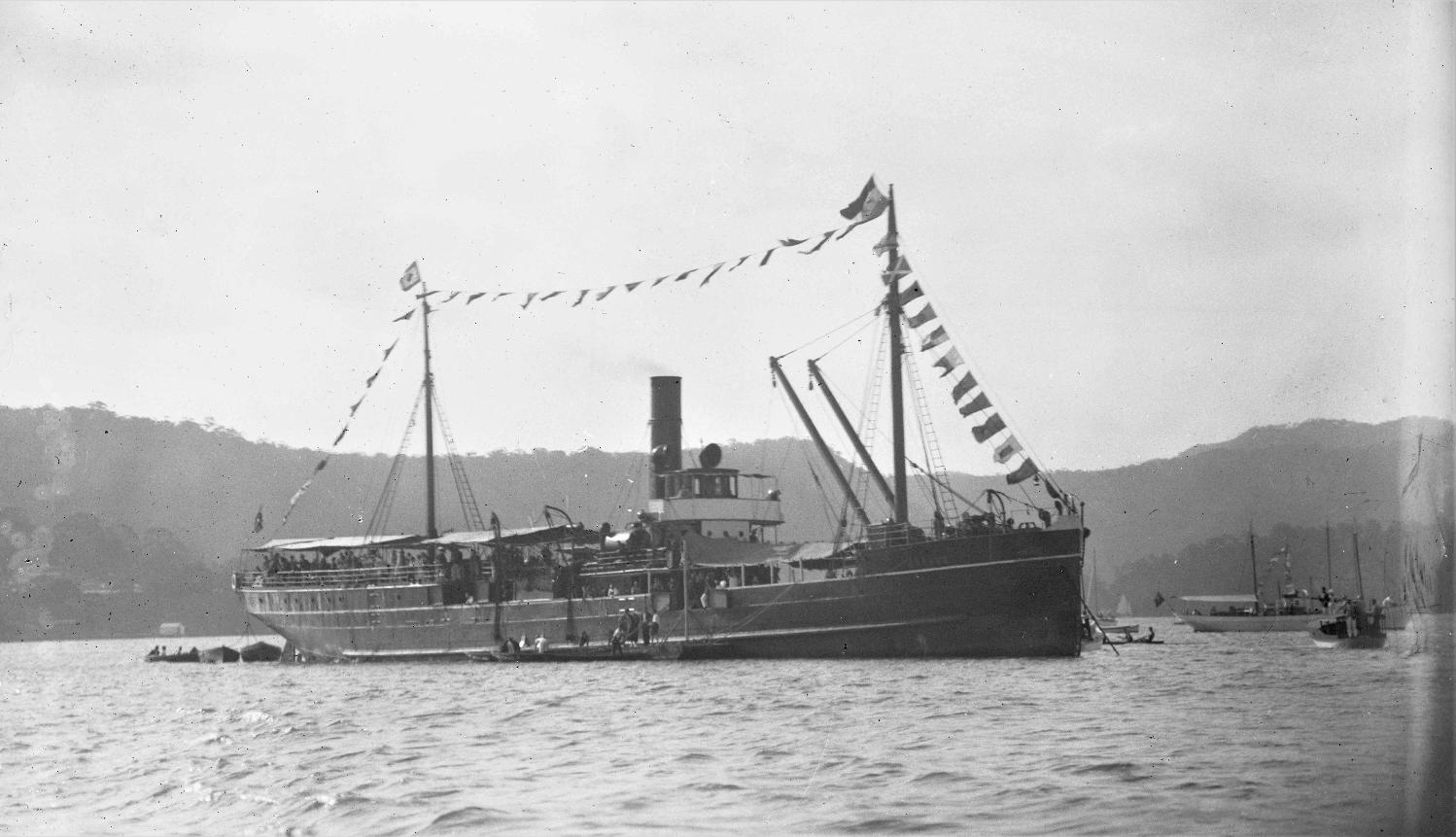
SS ARCHER as flagship at the Pittwater Regatta - photo is part of the Australian National Maritime Museum’s William Hall collection on Flickr. Object number 00010681
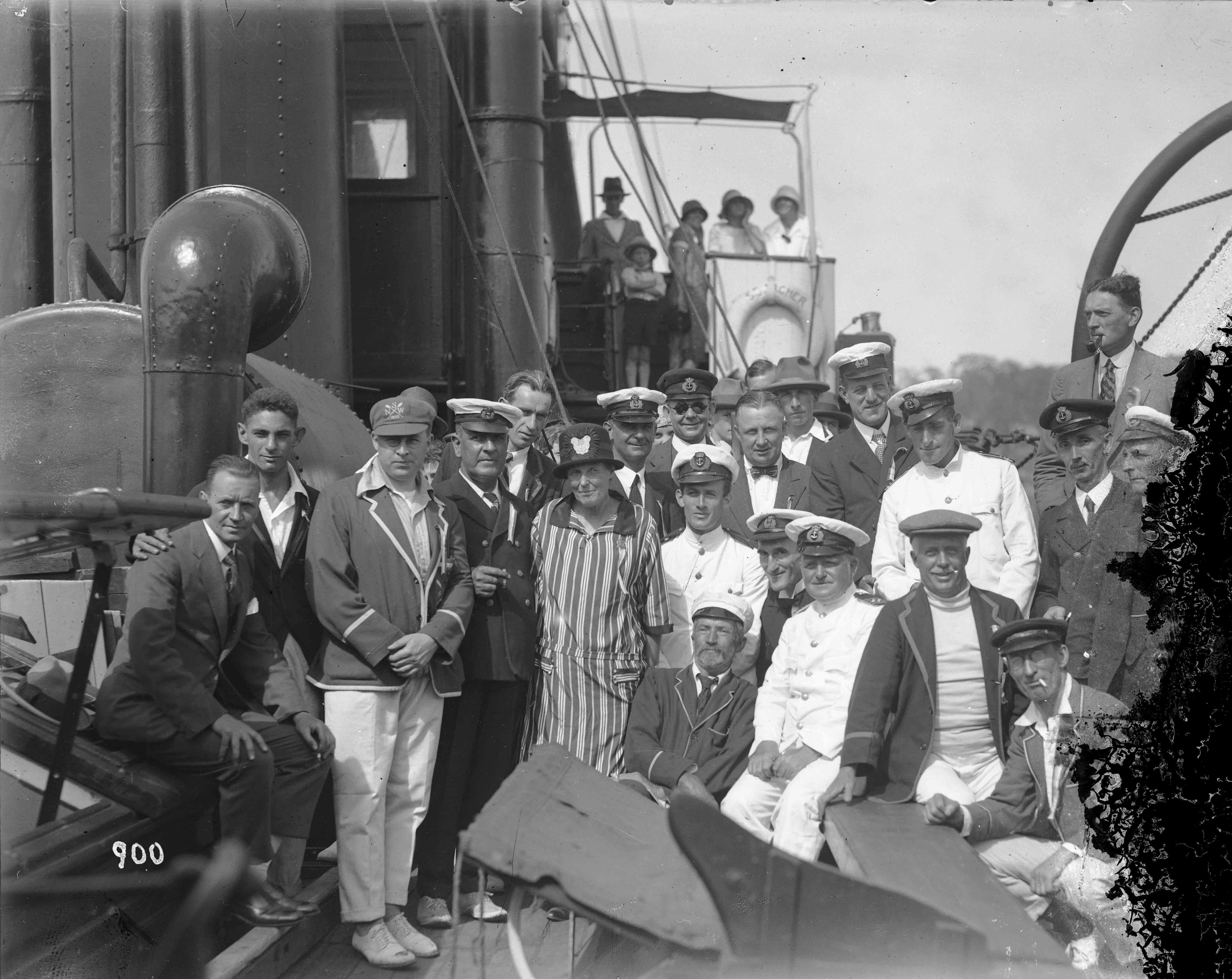
Committee members of the Pittwater Regatta onboard SS ARCHER, photo is part of the Australian National Maritime Museum’s William Hall collection, Object number 00010666
PITTWATER REGATTA PIONEERS
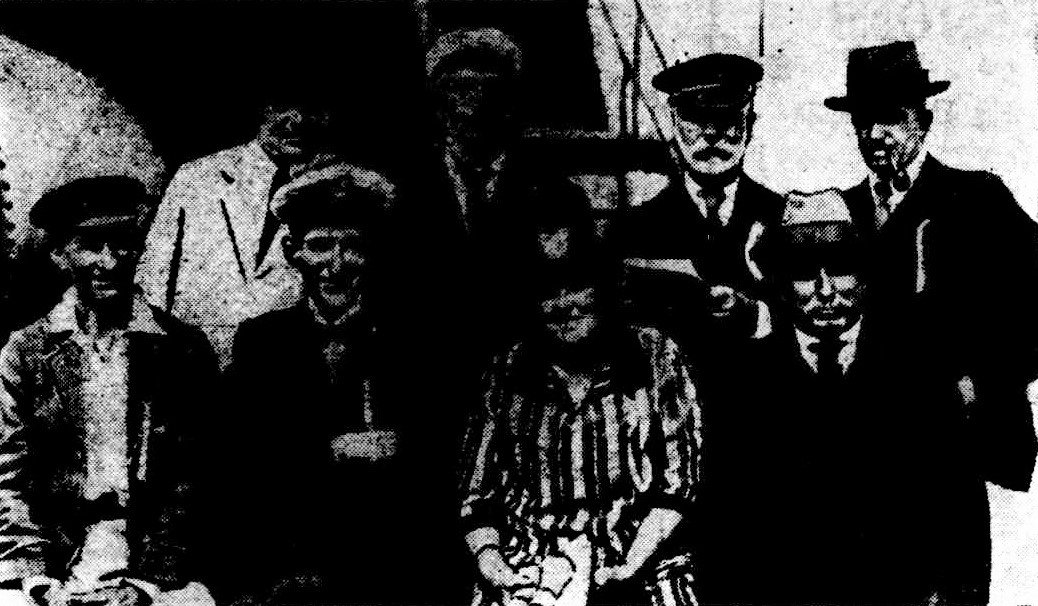
Back Row (left to right). — Messrs. A. L. Davis, John Williams, F. S. Adams, T. L. Mulhall. Front Row. — Messrs. S. J. Keegan, John Roche (hon. sec), Mrs. Greig, and Mr. W. Bolton.-The officials in this group officiated at the first Pittwater regatta 19 years ago, and were 'on deck' on Saturday. PITTWATER REGATTA PIONEERS. (1926, January 1). Arrow(Sydney, NSW : 1916 - 1933), p. 13. Retrieved from nla.gov.au/nla.news-article105944548
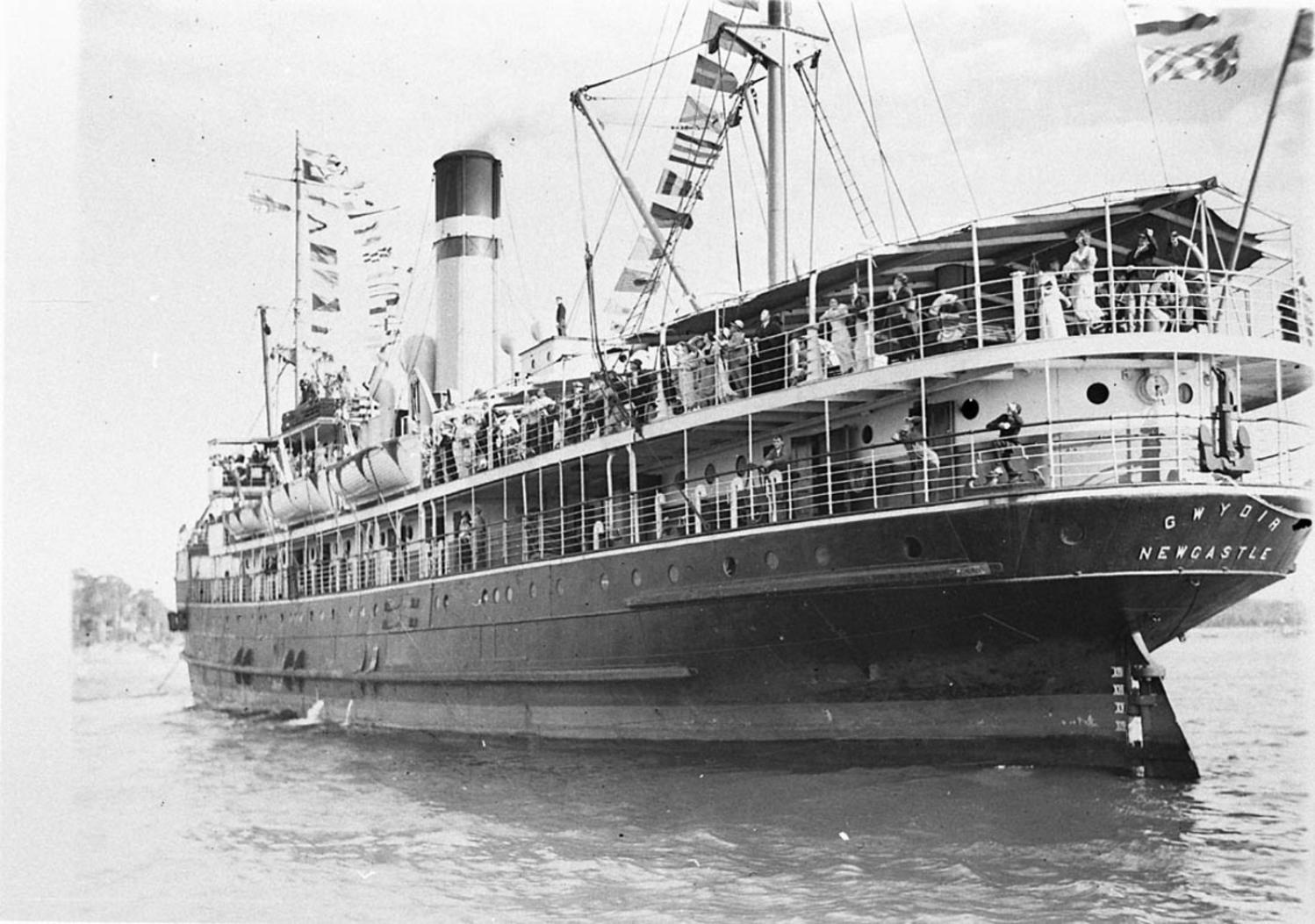
Hunter River Steamship Co.'s SS "Gwydir" as flagship at Pittwater Regatta, Item: hood_06534h, courtesy the State Library of New South Wales.